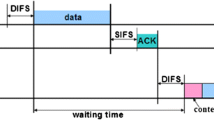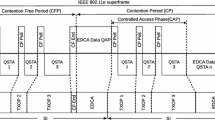Abstract
In this paper an Adaptive Priority Sliding Admission Control and Scheduling (APSAS) scheme is proposed to provide QoS over the existing IEEE802.11 WLANs which operate on Distributed Coordination Function (DCF) and Enhanced Distributed Channel Access (EDCA) mechanisms. The roles of this scheme are generally two folds: (1) To control the number of delay-sensitive real time flows that can be admitted into the WLAN Basic Service Set network and (2) To adjust the priority of selected real time flows in order to accommodate more real time flows without violating the QoS requirement. Extensive simulation studies show that APSAS improves the total throughput, flow throughput ratio, packets end-to-end delay, and jitter of the real time applications when compared with conventional best effort and scheduling-enhanced DCF/EDCA. APSAS also offers near to unity average throughput ratio, lower mean VoIP end-to-end packet delay (<130 ms) and lower mean video packet jitter (<130 ms) over DCF and EDCA.
Similar content being viewed by others
Explore related subjects
Discover the latest articles, news and stories from top researchers in related subjects.References
IEEE 802.11a WG, Part 11 (1999). Wireless LAN medium access control (MAC) and physical layer (PHY) specification: High-speed physical layer in the 5 GHz Band.
IEEE 802.11b WG, Part 11 (1999). Wireless LAN medium access control (MAC) and physical layer (PHY) specification: High-speed physical layer extension in the 2.4 GHz Band, IEEE.
IEEE Std 802.11g/D1.1, Part11 (2001). Wireless LAN medium access control (MAC) and physical layer (PHY) specifications: Further higher-speed physical layer extension in the 2.4 GHz Band.
Wi-Fi technical details. http://www.btopenzone.com/help/technical-details/index.jsp
BT lights up half a million wifi hotspots. Telecoms. com, August 20, 2009 http://www.telecoms.com/13962/bt-lights-up-half-a-million-wifi-hotspots
802.11n Device Unit Shipments Grow by 85 % Year over Year. In-Stat, July 21, 2010 http://www.instat.com/newmk.asp?ID=2816&SourceID=00000652000000000000
IEEE Std 802.11eTM-2005, Part 11 (2005). Wireless LAN medium access control (MAC) and physical layer (PHY) specifications: Medium access control (MAC) Quality of Service Enhancements.
Liu T. H., Liao W. J., Lee J. F. (2009) Distributed contention-aware call admission control for IEEE 802.11 multi-radio multi-rate multi-channel wireless mesh networks. Mobile Networks and Applications 1572-8153 14(2): 134–142
Yilmaz O., Chen I. R. (2009) Utilizing call admission control for pricing optimization of multiple service classes in wireless cellular networks. Computer Communications 32(2): 317–323
Nakajima, K., Mase, K., Okada H., (2009). A congestion control scheme for layer 3 wireless mesh networks. In Proceedings of the 15th Asia-Pacific conference on communications, APCC 2009, pp. 722–725.
Gracia R. S., Yannuzzi M., Tordera E. M., Bruin X. M., Sanchez S. (2010) Quality of experience enforcement in wireless networks. Lecture Notes in Computer Science 6074/2010: 180–191
Alwakeel S.S., Alotaibi N.M. (2011) End-to-end measurement based admission control VoIP protocol with loss policy. Journal of King Saud University—Computer and Information Sciences 23(1): 37–43
Qaimkhani I. A., Hossain E. (2008) A novel QoS-aware MAC protocol for voice services over IEEE802.11-based WLANs. Wireless Communication and Mobile Computing 9: 71–84
Yu R., Zhang Y., Huang C. (2010) Joint admission and rate control for multimedia sharing in wireless home networks. Computer Communications 33: 1–13
Huang C. J., Hu K. W., Chen Y. J., Luo Y. C. (2009) A QoS-aware VoD resource sharing scheme for heterogeneous networks. Computer Networks 53: 1087–1098
Cano C., Bellalta B., Sfairopoulou A. (2010) Tuning the EDCA parameters in WLANs with heterogeneous traffic: A flow-level analysis. Computer Networks 54(13): 2199–2214
Rebai , A. R., Hanafi S. (2011) A dynamic multimedia user-weight classification scheme for IEEE802.11 WLANs. International Journal of Computer Networks and Communications (IJCNC) 3(2): 217–231
Lagkas T., Chatzimisios P. (2011) AWPP: A new scheme for wireless access control proportional to traffic priority and rate. EURASIP Journal on Wireless Communications and Networking 2011: 1–11
Zorba N., Verikoukis C. (2010) A QoS-based dynamic queue length scheduling algorithm in multiantenna heterogeneous systems. EURASIP Journal on Wireless Communications and Networking 2010: 1–10
LiMing , Zhu H., Prabhakaran B. (2010) Dynamic priority re-allocation scheme for quality of service in IEEE 802.11e wireless networks. Wireless Networks 16: 759–774
Pang W. L., Chieng D., Nadia N. (2009) Enhanced layer 3 service differentiation for WLAN. WSEAS Transactions on Systems 8(5): 649–658
Ahmed, M., Fadeel, G. A., Ibrahim, I. I. (2010). Differentiation between different traffic categories using multi-level of priority in DCF-WLAN. In Sixth advanced international conference on telecommunications, pp. 262–267, 9–15.
Pang W.L., Chieng D., Nadia N. (2010) A practical layer 3 admission control and adaptive scheduling (L3-ACAS) for COTS WLANs. Wireless Personal Communication 16(13): 655–674
Yilmaz O., Chen I. R. (2009) Elastic threshold-based admission control for QoS satisfaction with reward optimization for servicing multiple priority classes in wireless networks. Information Processing Letters 109(15): 868–875
Cetinkaya C. (2009) Service differentiation mechanisms for WLANs. Ad Hoc Networks 8(1): 46–62
Xiao Y., Li F. H., Choi S. (2009) Two-level protection and guarantee for multimedia traffic in IEEE 802.11e distributed WLANs. Wireless Networks 1022 0038 15(2): 141–161
Kim S., Cho Y.J., Kim Y.K. (2009) Admission control scheme based on priority access for wireless LANs. Computer Networks 54(1): 3–12
Floyd S., Jacobson V. (1995) Link-sharing and resource management models for packet networks. IEEE/ACM Transactions on Networking 3: 365–386
The Network Simulator—ns2, http://www.isi.edu/nsnam/ns.
Author information
Authors and Affiliations
Corresponding author
Rights and permissions
About this article
Cite this article
Pang, W.L., Chieng, D. & Ahmad, N.N. Adaptive Priority Sliding Admission Control and Scheduling Scheme for DCF and EDCA WLANs. Wireless Pers Commun 70, 295–321 (2013). https://doi.org/10.1007/s11277-012-0695-2
Published:
Issue Date:
DOI: https://doi.org/10.1007/s11277-012-0695-2




